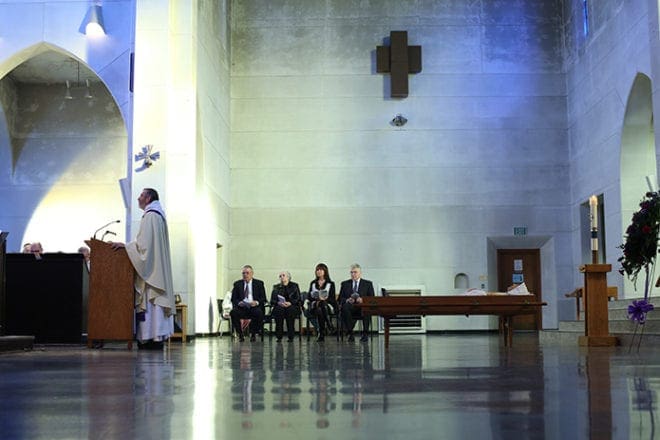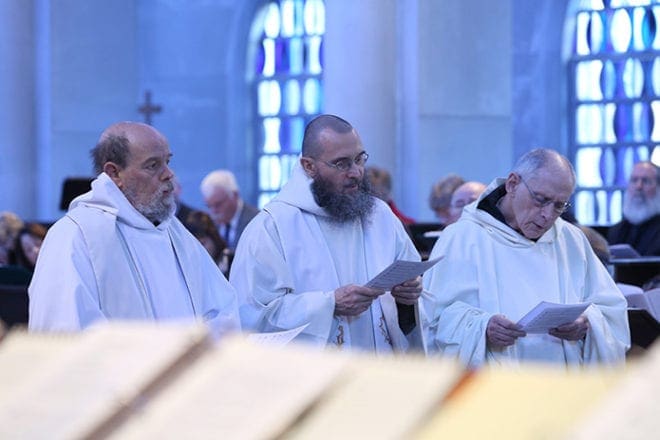 Photo By Michael Alexander
Photo By Michael AlexanderConyers
Monastery’s last living founder, Father Luke Kot, dies at 102
By ANDREW NELSON, Staff Writer | Published January 23, 2014
CONYERS—Shovels of red dirt were dropped in the sign of the cross onto the shroud-wrapped body of Father Luke Kot as the community of Trappist monks buried their beloved brother.
The joyful, ancient Psalm 118 accompanied him on his final journey from the nearby abbey church. “Give thanks to the Lord, for he is good, for his mercy endures forever,” sang the monks, dressed in white cowls, as the remains were carried to the grave.

Father Luke Kot, OCSO
Photo By Michael Alexander
Father Luke was 102. He was the last survivor of the first generation of 21 monks who established the Monastery of the Holy Spirit. He died on Jan. 9.
The peal of the tower bells sounded the start of the service. Light shining through the stained glass turned the austere stone church blue. Close to 150 friends and admirers paid their respects to the cloistered monk, who entered religious life in 1938. They filled the wooden choir seats lining the church nave, as more crowds sat in the pews in the rear.
At the foot of the sanctuary, the open casket had stayed in the abbey church overnight, Father Luke’s body dressed in a cowl and the vestments of a priest and simple black shoes. As is tradition, the monks “kept night watch” and prayed for him continually since the vespers prayer service at sunset Jan. 12.
During the funeral Mass on Jan. 13, visitors paid their respects as they passed the casket, patting his hands as they came forward to receive Communion.
There was sadness with his death, especially for what the community has lost. He was the patriarch of the monastery, which now numbers some three dozen men. His was the fifth death in the past 12 months.
“It’s like a light has shown and that light has gone out,” said Brother Callistus Crichlow.
But there was also thanks for a life well lived.

Abbot Francis Michael Stiteler, standing, Monastery of the Holy Spirit superior, reflects on the good times surrounding the life of Cistercian Father Luke Kot. The 102-year-old monk, who died Jan. 9, came to Conyers in 1944 when the Trappist monastery was founded.
In fact, Abbot Francis Michael joked and called Father Luke, “Conyers’ most famous monk.”
He recalled in his homily how his fellow monk told him his goal was “to be nothing.”
Father Luke’s unique way drew people close, he said.
“He knew how to be loved. He made you feel important because he shared a story with you, his pearls of wisdom,” he said.
In fact, he was among many drawn into Father Luke’s orbit.
“Many of us are not easy to hug. Father Luke, I kissed him on the forehead or the cheek every time I saw him,” the abbot said.
Father Luke gave an “incredible witness” when he allowed people to love him, he said.
An approachable man, Father Luke loved to tell stories, laugh, and share time with people. He relished small things, like bologna sandwiches.
A Polish family, Teresa and Andrzej Wor and their daughter, Magdalena, befriended Father Luke in the late 1990s when they learned of a Polish monk at the monastery. They spoke Polish to him, which made him very happy, said Andrzej. Father Luke told them he used to practice his Polish by speaking to squirrels, he laughed.
“He had a way with people. He made you feel so important to him,” said Magdalena, a professional musician who sang during the funeral. One of her albums was in his infirmary room.
“It’s a way to say goodbye to Father Luke,” she said.
For nephew George Truesdale, of Chicago, the monk was “Uncle Joe.”
“He was a very special person in our family’s life. My mother loved him dearly. He was loved by everybody,” said Truesdale, who attended the funeral with his wife, Teresa. He recalled his family getting Father Luke’s hand-sewn pillows and towels.
“I was a little kid, but he’d talk to me like an adult,” he said about his uncle’s visits.
“I wanted to be a simple religious. A nobody would be the best thing,” Father Luke told The Georgia Bulletin in 2009. “I don’t try to be too religious, or try to be too monkish.”

Cistercian monks (l-r) Father James Behrens, Father Gerard Gross and Brother Elias Marechal sing the responsorial psalm during the Jan. 13 Mass of Christian Burial for Father Luke Kot. Photo By Michael Alexander
He was the son of Polish immigrants, whose father worked as a carpenter and mother as a midwife. And his infirmary room showed his pride in his Polish heritage. He decorated the room with an illustration of Blessed John Paul II being hugged by the Virgin Mary and prayer cards of Our Lady of Czestochowa written in Polish. A photo of Blessed Father Jerzy Popieluszko was near his bed. Father Popieluszko, outspoken in defense of the Polish people and laborers through Catholic teachings and sermons, was murdered in 1984 by communist agents in Poland.
Father Luke was born in Montana, but grew up in Niagara Falls, N.Y. He was the only boy with three sisters. At the age of 27, he joined the Order of Cistercians of the Strict Observance, commonly known as the Trappists. He became a novice at Our Lady of Gethsemani monastery in Kentucky. His time there overlapped with the famous writer and monk, Thomas Merton. The Conyers monastery was founded in 1944 by monks, including Father Luke, who were sent from Gethsemani to make the foundation in rural, largely non-Catholic Georgia.
He lived most of his life within the walls of the monastery, and it taught him a gentle side of God.
“God isn’t picky-choosy like we are,” he said. “God takes everything you give him because God is love.”
Father Luke accepted the tasks that served the community. A factory laborer after high school, he set out to live as a brother and perform manual labor. However, a superior told him to get an education to become a priest. He served as the abbot’s secretary for years, despite asking instead to fill wheelbarrows during the monastery construction. Then he became responsible for the monks’ distinctive habits. For more than 50 years, Father Luke was the tailor. In his 90s, he worked in the welcome center, befriending visitors like Pat and Carol Losack. They chatted for an hour at their first time meeting when they learned he was 98. They later were invited to attend, along with many others, his 100th birthday.
“The guy was just pure joy. He oozed love,” said the Canton resident who attends St. Michael the Archangel Church, in Woodstock.
In his final years, he lived in the infirmary helping with simple tasks. It’s where Claire Smith worked as a nurse and got to know him. She is convinced she met a saint. He had a gift to look at each day with joy, without worrying about the past or the future, she said.
“The nonjudgmental love that he showed every living human was nothing less than astonishing,” she said in an email. “You could see the genuine love and care in his eyes, the window to the soul.”